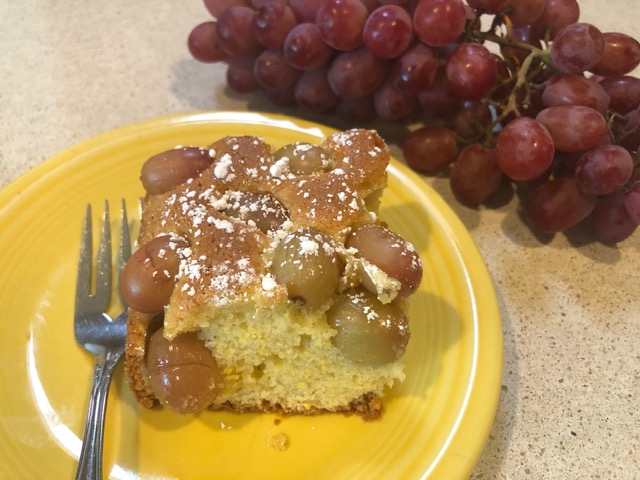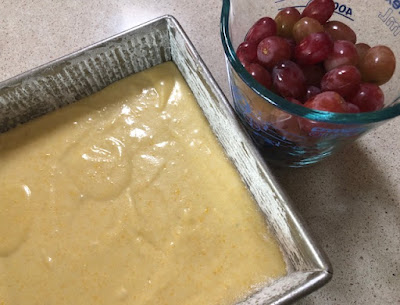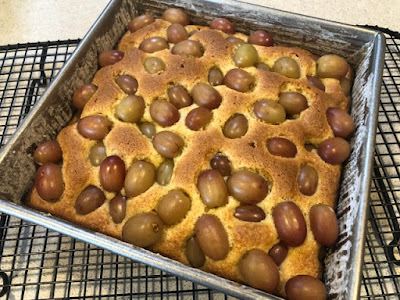
Recipe: Red grapes roast atop a lemon-scented batter
 |
| Grapes top the polenta-specked lemon and olive oil cake. (Photos: Kathy Morrison) |

|
The fruit at the farmers market right now exemplifies the change of weather and change of seasons: The last peaches and nectarines over here, the early-season persimmons and pomegranates over there. In between are pears, apples and, oh my, look at those grapes!
I don't buy grapes often, but the displays of red, green and black grapes from several vendors could not be ignored. I settled on two pounds of beautiful Crimson Flame grapes, and then dug into recipes to see how to use them.
This recipe, which has olive oil and polenta in the batter, is one I adapted from a gluten-free version on the blog This Mess is Ours. I guess I'm on an Italian-inspired baking kick this fall, but there's nothing wrong with that.
This cake is sweet enough to serve for dessert with espresso, but it's uncomplicated enough to be a breakfast cake. Other fruit could go on top instead of grapes, but try it first with your favorite red seedless. Left whole, the grapes roast into delicious little nuggets of flavor.
I used medium-grind polenta here, but if the grittiness would bother you, use fine-grind or even regular cornmeal.

The cake batter is ready to be topped with half the
grapes to begin baking.
|
Olive oil cake with polenta and roasted grapes
Serves 9-12
Ingredients:
1/2 cup almond flour or almond meal
1/2 cup good-quality olive oil, plus more for pan
1 cup unbleached all-purpose flour (can use gluten-free flour if desired), plus more for pan
1/4 cup polenta, fine or medium grind
1-1/2 teaspoons baking powder
1/2 teaspoon kosher salt
2 large eggs
2/3 cup sugar
Zest from 1 large lemon
1/3 milk (dairy or non-dairy, but not non-fat)
2 cups red seedless grapes, washed but left whole
Confectioner's sugar, for topping, optional
Instructions:
Heat oven to 350 degrees. Place a sheet of parchment paper on a rimmed baking sheet, and scatter the almond flour over the paper. Toast the almond flour in the oven for 4 to 5 minutes, until it is fragrant, but be careful not to scorch it. Remove from oven and allow to cool a few minutes.
Brush a round or square 8-inch pan with olive oil, then dust with a bit of all-purpose flour.
In a medium bowl, whisk together the all-purpose flour, the toasted almond flour, polenta, baking powder and kosher salt.
In a large bowl, use an electric mixer to beat together the eggs, sugar and lemon zest on high until the mixture is light and fluffy. With the mixer on low speed, stream in the olive oil until combined. Then, alternately add the flour mixture and the milk, starting with about one-third of the flour, then half the milk. Repeat, then stir in the remainder of the flour.

Fresh out of the oven, the cake can be topped with
confectioner's sugar or left plain. |
Spread the batter in the prepared pan. Scatter about 1 cup of the grapes over the top of the batter. Bake for 15 minutes, then add the rest of the grapes to top, pressing down on them just slightly. Continue baking for 25 to 27 minutes more, until the cake is golden brown and a toothpick inserted in the center comes out clean.
Allow cake to cool about 15 minutes on a wire rack. Sprinkle confectioner's sugar on top, if using, and slice to serve.
Comments
0 comments have been posted.Sacramento Digs Gardening to your inbox.
Food in My Back Yard Series
April 1: Don't be fooled by these garden myths
March 25: Fertilizer tips: How to 'feed' your vegetables for healthy growth
March 18: Time to give vegetable seedlings some more space
March 11: Ways to win the fight against weeds
March 4: Potatoes from the garden
Feb. 25: Plant a fruit tree now -- for later
Feb. 18: How to squeeze more food into less space
Feb. 11: When to plant? Consider staggering your transplants
Feb. 4: Starting in seed starting
Sites We Like
Garden Checklist for week of March 30
Your garden doesn’t mind April showers. Get busy now to enjoy those future flowers.
* Get ready to swing into action in the vegetable garden. As nights warm up over 50 degrees, start setting out tomato, pepper and eggplant transplants.
* From seed, plant beans, beets, cantaloupes, carrots, corn, cucumbers, melons, pumpkins, radishes and squash. (Soak beet seeds overnight in water for better germination,)
* Plant onion sets.
* In the flower garden, plant seeds for asters, cosmos, celosia, marigolds, salvia, sunflowers and zinnias.
* Transplant petunias, zinnias, geraniums and other summer bloomers.
* Plant perennials and dahlia tubers for summer bloom.
* Transplant lettuce and cabbage seedlings.
* April is the last chance to plant citrus trees such as dwarf orange, lemon and kumquat. These trees also look good in landscaping and provide fresh fruit in winter.
* Smell orange blossoms? Feed citrus trees with a low dose of balanced fertilizer (such as 10-10-10) during bloom to help set fruit. Keep an eye out for ants.
* Apply slow-release fertilizer to the lawn.